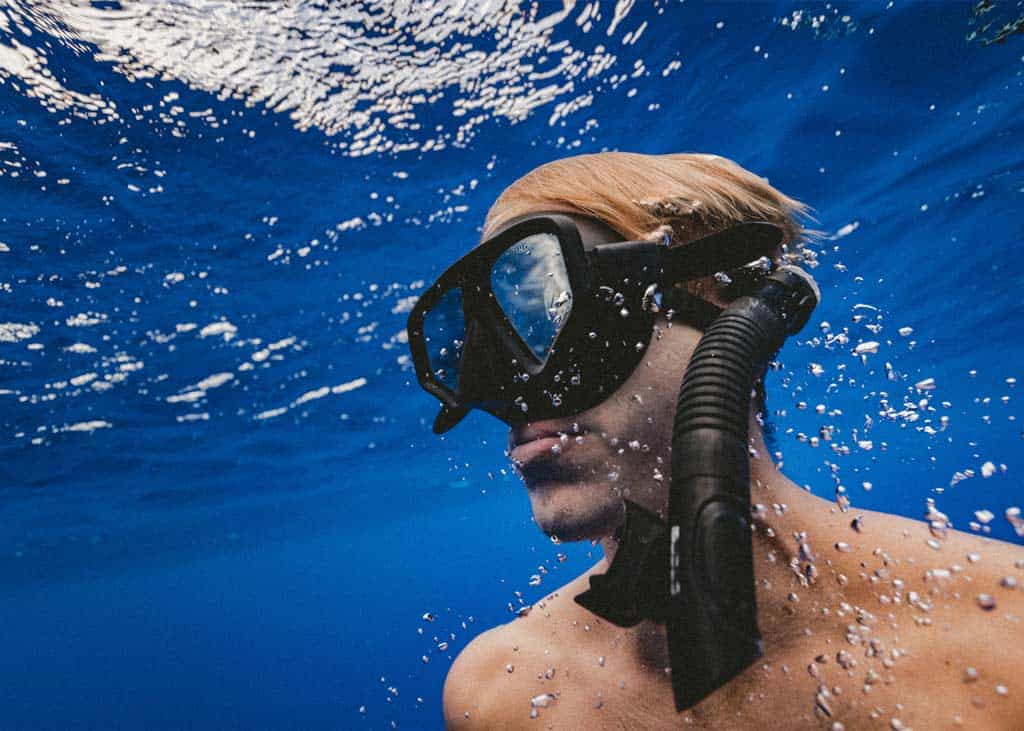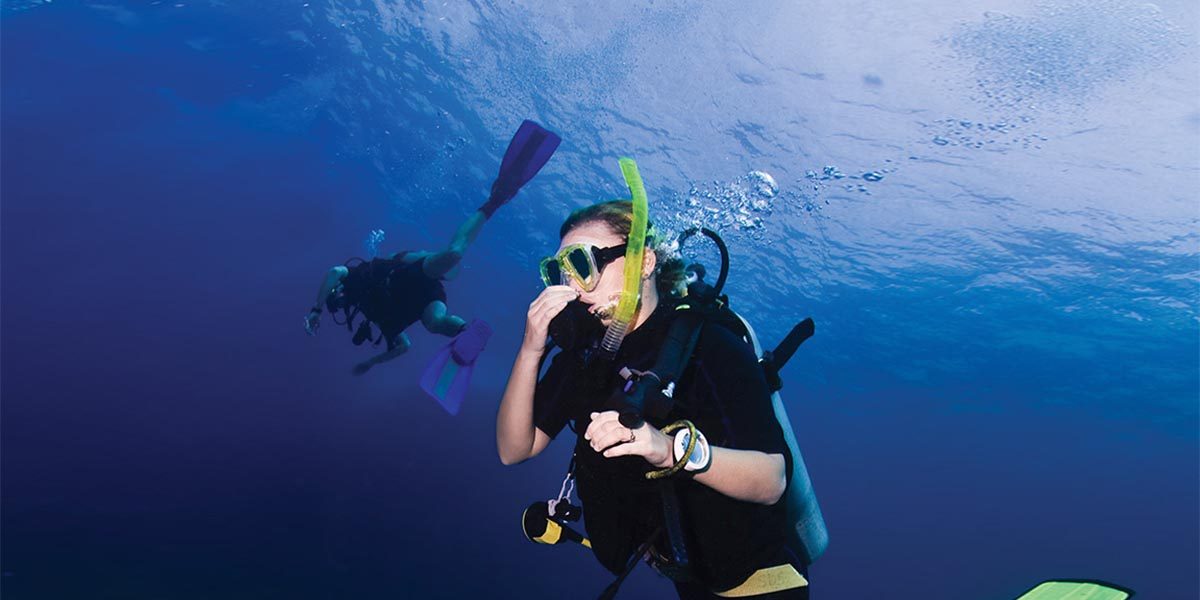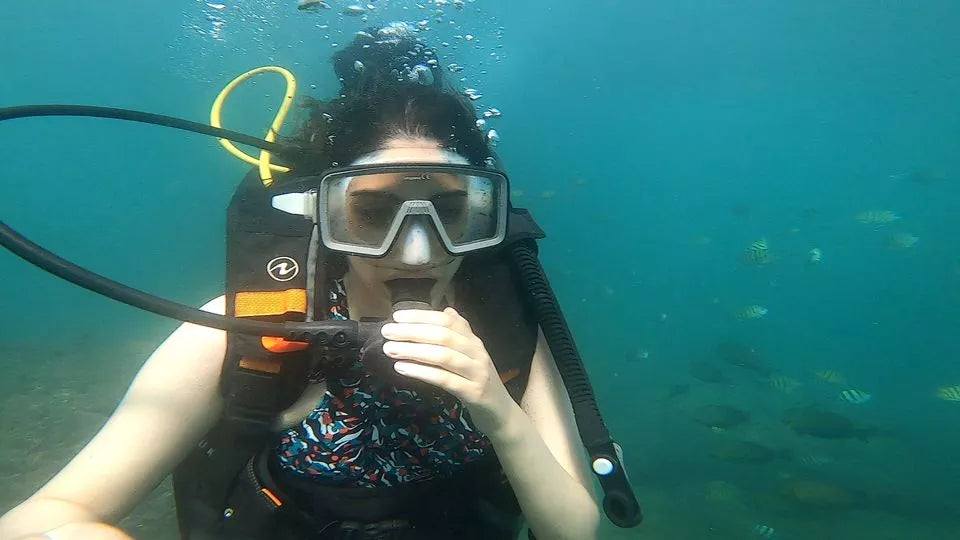It is recommended to check the elasticity every 6-12 months.it is recommended to replace a new mouthpiece every 3-6 months. High-frequency users (more than 3 times a week) need to check them around 1 year. Additionally, the neoprene wetsuit's insulation layer will fail after 3-5 years of frequent use (more than 50 times per year), and it needs to be replaced even without holes.
Mask rubber ring
Laboratory data shows that silicone rubber soaked in 3.5% salt water for 6 months experiences a decrease in elastic modulus of about 30% (hardening); continuous exposure to UV light (such as 2 hours daily in tropical areas) results in fine cracks appearing on the surface after 12 months. In actual use, low-frequency users (less than 3 times a week) are advised to compulsorily replace it every 12 months; high-frequency users (3-5 times a week) should focus on checking every 6-8 months (a new skirt recovers in 1 second after pressing, an aged skirt takes 2 seconds or more).
Salt in the Seawater
Laboratory immersion tests using 3.5% concentration salt water (simulating seawater): the initial elastic modulus (a measure of softness/hardness) of a new skirt is 1.2 MPa, dropping to 0.9 MPa after soaking for 3 months (12.5% harder), and only 0.84 MPa after 6 months (a cumulative decrease of 30%).
High seawater temperatures in tropical regions (28-30) accelerate chemical reactions, resulting in a 15% greater decrease in elasticity after 6 months compared to temperate seawater (20).
Invisible Cracks
A test placing a skirt outdoors in Hawaii (daily UV index 8, about 2 hours of direct exposure) showed that the surface started becoming sticky after 1 month (plasticizer loss), fine cracks were visible under a microscope after 3 months (width 0.01), and crack length reached 0.5after 6 months.
Data from a German diving equipment laboratory shows that a mask skirt exposed to long-term sun has a 4 times higher probability of leakage after 12 months than a non-exposed skirt.
Cleaning Agents
A test wiping the skirt with 75% alcohol 3 times a week showed that the plasticizer content dropped from an initial 15% to 8% after 3 months (a new skirt is 18%), and the skirt's hardness increased by 20%. one wipe can shorten the skirt's life by 10%. Specialty silicone cleaning agents commonly used by divers are much better; in a similar test, using it once a month resulted in only a 5% decrease in skirt performance after 12 months.
Time Takes its Toll
A laboratory test sealing a skirt in an opaque, dry container (simulating non-use) showed a 10% decrease in elastic modulus after 1 year and a 20% decrease after 2 years. This is why brands recommend replacing the skirt even if it is not used every year - time itself consumes its lifespan.
Different Skirt Materials
Standard silicone rubber is the most common and ages the fastest; fluorosilicone rubber is highly corrosion-resistant (only a 15% drop in elasticity after 1 year of soaking in seawater) but is 30% more expensive; EPDM is cheaper but has poor temperature resistance (accelerated aging above 35).
Slow Rebound after Pressing
The feel of a new skirt is that it "puffs" in when pressed and immediately springs back within 1 second, like pressing a soft balloon. An aged skirt will "collapse" slowly when pressed, with a rebound time exceeding 1.5 seconds - this is not an illusion, but a loss of elasticity caused by the breaking of silicone rubber molecular chains.
The Cressi laboratory measured this with instruments: a skirt used for 6 months saw its rebound time increase from 1 second to 1.3 seconds; after 12 months, it reached 1.8 seconds, at which point the sealing performance had decreased by 25%.
Bubbles in the Water
If the mask is worn normally without tape, and you immerse your head in shallow water up to your chin (simulating entry into the water), continuous small bubbles (1-2 bubbles per second) around the nose bridge or eyes indicate a leak in the skirt.
TUSA conducted a comparative test: a new skirt had almost no bubbles underwater, a skirt used for 9 months showed continuous bubbles in 7 out of 10 tests; a 12-month-old skirt leaked in all 10 tests.
How it feels to the touch
Dive Gear Express inspection showed that: after 1 year of use, the plasticizer content on the skirt's surface dropped from an initial 12% to 5%, and the texture became noticeably sticky; after 18 months, oxidized "powdering" particles appeared in some areas
Don't Wait Until it Breaks
Laboratory simulations showed: when the rebound time reaches 1.5 seconds, an occasional bubble appears, and it feels slightly sticky, the probability of leakage has already increased from 1% for a new skirt to 10%; once all three signals appear, the probability of leakage exceeds 30%.
How to Maintain
While skirt aging is inevitable, proper maintenance can extend its lifespan by 30%-50%. Tests show: an unmaintained skirt experienced a 30% decrease in elasticity after 12 months; a skirt that received basic maintenance saw only an 18% decrease in the same period. Divers who spend 5 minutes a week on maintenance reduced their average annual skirt replacement frequency from 2.3 times to 1.1 times
Rinse Salt with Fresh Water
After each dive, immediately rinse the skirt with fresh water below 25; don't wait until you get home to deal with it. Chloride ions in seawater adhere to the skirt's texture, and staying for more than 1 hour accelerates corrosion by 40%.
Avoid hot water (35), as high temperatures can soften and deform the silicone rubber. Tests showed that rinsing the skirt with 40 hot water 10 times resulted in slight surface indentations. Rinsing with fresh water removes over 90% of salt residue and is the most cost-effective first step in maintenance.
Air Dry in the Shade
Don't rush to put it away after rinsing; hang it in a ventilated, shaded area for 2 hours, avoiding direct sunlight (UV light dries out the plasticizer) and keeping it away from heaters or hair dryers (high temperatures accelerate oxidation).
The ideal location is a hook 30 off the ground, maintaining air circulation. Laboratory simulations: skirts air-dried on a balcony (semi-shaded) had 25% less plasticizer loss after 12 months than those stored in a closet (sealed and damp).
Minimize Alcohol Wipes
75% alcohol dissolves the plasticizer. A test wiping the skirt with alcohol 3 times a week showed that the plasticizer content dropped from 15% to 8% after 3 months (a new skirt is 18%), and the skirt's hardness increased by 20%.

Snorkel Mouthpiece Replacement
Silicone mouthpieces used for 3 hours daily at high frequency will develop fine cracks on the edges after 3-4 months; if used 2-3 times a week, the elasticity at the biting area decreases after 6-8 months, potentially causing leaks. Check for frayed edges, a soft, collapsed feeling when pinching, or a pour-water-and-invert test - if water seeps from the bottom at a rate exceeding 3 drops/minute, it's time to replace it. Due to chewing habits, children's mouthpieces are recommended for mandatory inspection every 4 months.
Material Hardens
Silicone maintains elasticity through molecular chain cross-linking, and UV light breaks these molecular chains, with Shore A hardness increasing by 2-3 degrees every month (initial hardness is about 70 degrees; it becomes hard and brittle when it exceeds 80 degrees).
If continuously soaked in seawater for 3 days without cleaning, the water absorption of the silicone increases by 15%.
Wear and Tear Over Time
The friction force of a single bite is about 0.5text{ Newton}, which seems small, but 3 hours of use daily equals 5475 bites a year. After 200 hours of continuous use (about 1.5 hours daily for 4 months), 50% of the mouthpiece edges will show visible fraying.
A mouthpiece used by a 3-year-old can wear a 0.3deep notch in 2 months (compared to 0.1 wear on an adult mouthpiece in the same period).
Environment Accelerates Damage
Cressi testing found that a mouthpiece that is removed but not air-dried ages twice as fast after 3 months as one that is air-dried and stored, and a -10 environment hardens the silicone by 3-5 degrees.
Minor Issues
The mouthpiece edge may have a 0.01text{-millimeter} protrusion, or if the vulcanization process time is insufficient, the material is not fully cross-linked, directly shortening the lifespan by 30%.
How to Tell When to Replace It
Check the Frayed Edges
After 200 hours of continuous use (about 1.5 hours daily for 4 months), 50% of the mouthpiece edges will show 0.10.2text{-millimeter} fraying, like marks from being lightly scraped by a fingernail. This is more noticeable in children; due to chewing habits, a mouthpiece used by a 3-year-old can wear a 0.3deep notch in 2 months.
If you see more than 3 continuous small nicks on the edge, or if the overall contour becomes blurred, it's time to replace it.
Pinch for Softness
When the Shore A hardness exceeds 80 degrees (initial about 70 degrees), it feels soft and weak when pinched.
Install on the Snorkel
A normal mouthpiece should maintain a water column pressure of 5 inside the tube, and water should not pour out. If water immediately rushes out from the bottom of the mouthpiece when you blow, or if the water leaks out twice as fast as a new mouthpiece after you stop blowing (e.g., a new mouthpiece leaks 10 drops/minute, an old one leaks 20 or more), the seal has failed. Alternatively, fill a cup with water, immerse the bottom of the mouthpiece, and press the top of the mouthpiece; if air bubbles exceed 3 per second from the bottom, it also needs replacement.
Child Check
Children's chewing habits are unique, so in addition to the 3 steps above, you should also:
-
Check bite mark alignment: After biting a new mouthpiece, the upper and lower tooth marks are symmetrical; an aged mouthpiece is chewed askew, indicating that the material has softened and cannot withstand the force.
-
Smell for strange odors: Children often keep the mouthpiece in their mouths, and aging material can breed bacteria; if you smell a sour odor when you get close, it should be replaced even if it is not leaking.
Quick Screening
-
If wiping with a paper towel reveals fine rubber debris, the edge is deteriorating.
- If the mouthpiece becomes lighter after air-drying and feels hollow when pinched, the interior may be cracked.
Wear and Tear Over Time
A lab test with a pressure sensor showed that: an adult's normal bite exerts a friction force of about 0.5 on the mouthpiece (equivalent to the force of gently crushing a grape with a hand). Each 2-hour dive involves about 1800 bites (calculated at 15 breaths per minute), and these 1800 frictions wear away an extremely thin layer of material from the mouthpiece edge - about 0.001 of wear per instance, invisible to the naked eye.
Daily Usage Duration
After 100 hours of continuous use (about 1.5 hours daily for 2 months), the cumulative wear on the mouthpiece edge reaches 0.1.
At 200 hours of use (about 1.5 hours daily for 4 months), the accumulated wear reaches 0.2; playing in the water for 1 hour daily can wear a 0.3deep notch in 3 months ( ).
Children's Chewing
The biting force of children aged 3-6 is about 1015text{ Newtons} (adults are about 5070text{ Newtons}). The frequency of friction per hour for children's mouthpieces is twice that of new users (about 30 times/minute). A 2-month-old child's mouthpiece will show radial small cracks on the edge.
Different Materials Wear Faster
The Mohs hardness of silicone is about 3 (similar to a fingernail), and TPE is about 2.5 (softer), but TPE has better elasticity and can disperse friction.
Machine-simulated wear: the silicone mouthpiece wore 0.2 after 200 hours, and TPE wore 0.15 - TPE seems more durable, but the TPE surface is stickier and easily adheres to sand from seawater.
Sand particles (diameter 0.050.1) act like an abrasive, accelerating wear, so the actual wear rate for both is similar in use.
What Happens When It Wears Out
-
When wear exceeds 0.3, the mouthpiece's sealing performance begins to decline.
- A 0.5deep notch can cut the skin.
How to spot signs of wear
-
Look at the edge against the light; there will be fine nicks like strands of hair.
-
Feel with your finger; you can detect an uneven, "scratchy" texture.
-
When worn, the lips experience a slight stinging sensation (nicks scraping the skin).
Snorkeling Accessory Replacement Period
The mask silicone skirt seal gradually hardens after 6-12 months of contact with seawater and UV light. Used twice a week, slow rebound appears around 6 months; used four times a month, cracking may occur after 5 months. In humid environments, the coating fails every 12-18 months, presenting as yellowing of the inner wall and slight mold spots.
The fin's anti-slip rubber pad used for normal kicking (30 minutes each time, 3 times a week) sees its tread depth decrease from 2to below 0.5after 3-6 months, with grip decreasing by over 30%.
Snorkeling Mask
Water entering the mask during snorkeling is the most common issue, and over 90% is related to the aging of the silicone skirt seal. A new seal is made of food-grade liquid silicone, with a smooth, elastic surface that rebounds within 0.2.when pressed.
A mask used twice a week will have its skirt hardness increase from Shore A30 to A50 (similar to rubber turning into hard plastic) by the 6th month, and the rebound time will extend to over 0.5; high-frequency users (4 times a month) will see the skirt edge start to curl by the 5th month, and fine cracks will appear upon pressing.
Masks hung in a ventilated, dry place (such as a bathroom hook) are less affected by mold and humidity; for the same usage frequency, the lifespan of these mask skirts is shortened by 30%.
Inhale and hold your breath for 3 seconds. If you feel air leaking from the edge or a fine stream of water, the seal has lost its elasticity, or check the appearance: a new skirt has a neat edge without burrs, while an aged one will have edges lifted by 12, like curled paper.
Most brands (such as TUSA, Cressi) sell the skirt separately, priced at 515 USD, which is 70% cheaper than buying an entirely new mask (3080 USD).
High-frequency users (more than 3 times a week) are advised to check once every 5 months, while low-frequency users (1-2 times a month) can extend this to 8 months.
How to Check the
-
2 times a week snorkeling: Start checking monthly at the 6th month, mandatory replacement by the 7th month.
-
4 times a month swimming: Check at the 5th month, replace if the edge is curled.
-
Occasional use (once a month): Check at the 8th month, replace if it feels hard when pinched.
Replacing the
-
An average mask is 3080 USD, a separate skirt is 515 USD.
-
Storage affects lifespan
-
Storing in a damp backpack or sun exposure shortens the lifespan by 30%.
Anti-fouling Layer and Mouthpiece
Laboratory simulation tests show that in a 25 environment with 70% humidity (similar to the rainy season in Southern China), the anti-fouling layer fails completely every 12 months. If the tube is not air-dried after each use and is put directly into a backpack, the failure time is shortened to 8 months.
New silicone mouthpieces are soft with neat edges, conforming to the gums during biting; after 2 hours of daily use, the edges start to thin after 3 months, and you can feel fraying when lightly scratching with a fingernail; after 6 months, small cracks appear on the biting surface, allowing saliva to seep in and breed bacteria, leading to a strange odor in the mouth.
After 6 months of use, a properly stored snorkel's anti-fouling layer only shows slight yellowing, while a poorly stored one has large areas of mold, and the mouthpiece edges have fraying over 2 long.
The price of an ordinary snorkel is 1540 USD, which is cheaper than buying a high-end model with an anti-fouling layer (5080 USD), but high-frequency users are advised to replace it every 12-18 months.
The mouthpiece can be replaced separately; most brands have compatible models, 510 USD each, which is 70% cheaper than replacing the entire tube.
How the Anti-fouling Layer Fails
Check the inner wall: a new tube is smooth, after 3 months, water marks appear, after half a year, white spots (mold) appear, and after 1 year, large areas are yellow and sticky.
Checking Mouthpiece Wear
Feel the edge: a new mouthpiece is soft with no burrs, after 3 months the edge thins, and after 6 months there is fraying.
Trial bite: an old mouthpiece tends to slip down, requiring forceful biting, indicating poor elasticity, and the thickness may be only 1.
Storage Greatly Impacts Lifespan
Hanging in a ventilated area: the anti-fouling layer fails slowly, and the mouthpiece is less likely to smell.
Tossing in a damp bag: the anti-fouling layer molds after 8 months, and the mouthpiece edge has fraying over 2after 3 months.
Replace Tube or Mouthpiece
The anti-fouling layer cannot be replaced separately; only the entire tube can be replaced (1540 USD).
The mouthpiece can be replaced separately (510 USD); choose the same hardness, and avoid buying one that is too soft or too hard.

Rubber Pad Wear
New fin rubber pads have deep treads, commonly V-shaped or wave-shaped, with a depth usually between 1.52.5. The drainage grooves are 23 wide, quickly guiding water to generate thrust.
Laboratory mechanical simulation of kicking (frequency 40 times per minute, moderate force) shows that standard rubber pads (thermoplastic polyurethane material) after 300 hours (approximately 3 times a week, 30 minutes each use) have the tread depth reduced to below 0.5 and the drainage grooves widened to 5.
At this point, the grip decreases by 40%, and kicking efficiency decreases by 30%.Accelerating wear by another 20% - users who frequently kick off coral reefs or rocky areas can wear away the top 1 of rubber in 2 months.
Place a straight edge on the rubber pad surface; the difference between the highest and lowest points of a new pad's tread can exceed 2; when worn down to below 1, the straight edge is almost flat against the surface.
One-piece fins (where the rubber pad is integrated with the fin body) cannot have the pad replaced separately and must be completely discarded, costing 80200 USD; detachable fins (where the rubber pad is replaceable) can have the pad replaced separately, 3080 USD per pair, which saves 60% compared to replacing the entire pair.
When replacing the pad, be sure to choose the same hardness - Shore A60-70 soft rubber is suitable for beginners, offering stable kicking; A70-80 hard rubber is suitable for advanced users, providing strong propulsion. Proper storage can extend the lifespan by 25%.
High-frequency users (more than 4 times a week) are advised to check every 3-4 months, while low-frequency users (twice a month) can extend this to 5-6 months.
What Counts as Worn Flat
New pad treads are 1.52.5 deep, with a difference between high and low points exceeding 2 when measured with a ruler; when worn down to below 1, the ruler is almost flat against the surface, the drainage grooves widen, and grip decreases by 40%.
Signs of Difficulty Kicking
-
Sore feet: a new pad uses the reaction force; a worn pad requires extra effort from the lower leg, causing ankle soreness after 1 hour of swimming.
-
Slipping sensation: during high-speed kicking, the fin shifts under the foot, indicating insufficient friction between the rubber and the foot.
-
Muffled draining sound: a new pad drains with a "whoosh" sound, while a worn pad makes a "plop-plop" sound, and efficiency decreases by 30%.
Detachable Fins Can Have Pads Replaced Separately
One-piece fins must be entirely replaced when worn flat (80200 USD); detachable fins can have the pads replaced separately (3080 USD), saving 60%. Choose Shore A60-80 hardness; soft ones are stable, and hard ones have strong propulsion.






اترك تعليقًا
تخضع جميع التعليقات للإشراف قبل نشرها.
This site is protected by hCaptcha and the hCaptcha Privacy Policy and Terms of Service apply.